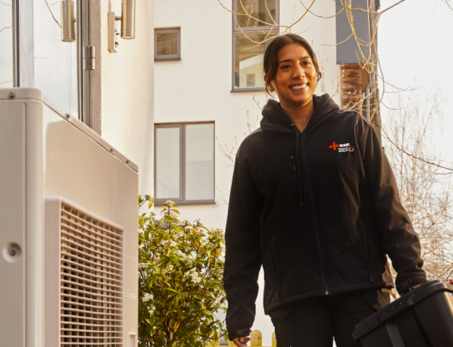If you have years of experience in the electrical industry, but are hampered by a lack of formal qualifications, the EWA could be your way forward.
What is the Experienced Worker Assessment?
The Experienced Worker Assessment (EWA) is a process designed for individuals who are already working in the electrotechnical industry, but who aren’t qualified to the industry Level 3 benchmark.If you have years of hands-on experience as an electrician, but are starting to find that your lack of formal qualifications is holding you back, then read on – the EWA might be the right qualification for you.
There are two main EWA ‘routes’, which tie in with the two main apprenticeship routes for electricians:
- Installation Electrician EWA – qualifies you to carry out commercial, industrial and domestic installations.
- Domestic Electrician EWA – qualifies you to carry out installations in residential properties.
Who is eligible for the EWA?
Prospective EWA candidates must complete a free initial self-assessment called the Skills Scan to prove their eligibility for the qualification.To be eligible to take the EWA, you must:
- Have worked in the electrotechnical industry for at least five years (for the Installation Electrician pathway) or three years (for the Domestic Electrician pathway). This does not include any time spent in training.
- Hold at least a Level 2 electrical qualification.
If you don’t have a Level 2 qualification, you may be eligible to take the Electrical Underpinning Knowledge and Understanding Test instead. This test, introduced in June 2025, replaces the need for a Level 2 qualification and allows you entry onto either one of the two EWA routes. Please note that the Electrical Underpinning Knowledge and Understanding Test isn’t a short cut to the EWA, and not all electricians without a Level 2 qualification will be eligible. It is designed for candidates who typically have at least 10 years’ experience working as an electrician and already possess the practical knowledge and theoretical understanding they need to move straight on to the EWA.
How does the EWA work?
Think the EWA might be right for you? Here’s how the process works.-
Complete the Skills Scan and Candidate Background Form
If you have at least ‘adequate’ experience in nearly all the sections, this suggests the EWA may be the right option for you.
If you have significant gaps in your knowledge or practical experience, you may need to undergo further training before taking the EWA, or you might decide to enrol on an apprenticeship or NVQ route instead.
-
Follow-up technical discussion
This will involve a process called ‘Recognition of Prior Learning’, which is designed to assess your existing qualifications, skills and experience against the EWA assessment criteria.
-
Filling in the gaps
-
Book your AM2E/AM2ED assessment
How long does the EWA take to complete?
The qualification must be completed within 18 months. Given that the EWA is designed for those who already have significant technical knowledge and practical experience, however, most learners will complete the EWA within six – 18 months and it can be done in as few as three.The amount of time it will take you to complete the EWA will depend on factors such as:
- How long it takes you to generate the portfolio of evidence required.
- Whether you need to undertake any additional training (such as 18th Edition or an inspection and testing qualification) to complete the EWA.
It allows you to be accredited to the same industry standard of your peers who have qualified through more traditional training routes.
How is the EWA assessed?
The EWA is assessed via a combination of on-site assessments, portfolio building, and the AM2E (Installation Electrician route) or AM2ED (Domestic Electrician route) end-point assessment. This final assessment is designed to mirror the assessment taken by electrical apprentices at the end of their training.If you do not have them already, you will also be required to undertake the following qualifications:
- An up-to-date Wiring Regulations qualification, such as NICEIC’s Level 3 Award in 18th Edition (2382-22) Requirements for Electrical Installations BS 7671.
- An initial verification inspecting and testing qualification, such as NICEIC’s Level 3 Award in the Initial Verification of Electrical Installations (Installation Electrician route).
- An initial and periodic inspection and testing qualification, such as NICEIC’s Level 3 Award in Initial and Periodic Electrical Inspection and Testing (Domestic Electrician route).
Your portfolio
Your portfolio will need to include projects that provide evidence of your competence across the following Level 3 performance units:Domestic Electrician
- Apply Health, Safety and Environmental Considerations in Dwellings
- Plan and Oversee the Electrical Work Activities in Dwellings
- Apply Design and Installation Practices Including Termination and Connection of Conductors in Dwellings
- Inspect, Test, Report and Commission Electrical Systems in Dwellings
- Apply Fault Diagnosis and Rectification in Dwellings.
Installation Electrician
- Apply Health, Safety and Environmental Considerations
- Organise and Oversee the Electrical Work Environment
- Terminate and Connect Conductors
- Inspect, Test and Commission Electrical Systems
- Apply Fault Diagnosis and Rectification
- Apply Design and Installation Practices and Procedures.
AM2E/AM2ED Assessment
This practical assessment is the final step in the EWA process and can only be booked and completed once you’ve completed all the above steps. It usually takes place over a three-day period.You will be asked to undertake several practical electrical tasks covering safe isolation, installation, fault-finding and inspecting and testing, which will be assessed by an experienced electrician.
I’m already working as an electrician – why do I need the EWA?
If you’re an electrician with significant hands-on experience in the industry, you might be wondering why you’d bother with the time and effort of an additional qualification.Here are just a few of the ways that having a formal Level 3 qualification can enhance your career:
-
You can join NICEIC
NICEIC certification, as well as being a recognised mark of quality among domestic consumers, is often compulsory to be considered for large construction tenders and projects for public sector bodies such as local councils and housing associations.
-
You can apply for an ECS gold card
The card is recognised across the industry as proof that you are a fully qualified electrician, with the ability to work safely and independently on the installation, commissioning and maintenance of electrotechnical systems. It’s a further mark of quality, building your credibility with customers and opening up additional work opportunities.
-
You can undertake further training and qualifications
For example, NICEIC’s renewables courses are part of the Electrician Plus scheme, which requires all learners to be fully qualified to Level 3 standard, ensuring they already have the necessary grounding in electrical fundamentals and theory.
And, given that almost 60% of homeowners in a recent survey expressed interest in installing solar panels, while 26% were considering installing a heat pump, building your skills with advanced training courses could open up significant opportunities for your business.
Why should I do the EWA with NICEIC?
There are so many benefits to doing your EWA qualification with NICEIC.-
Affordable payments
-
A reputation for training excellence
If you haven’t already done the BS 7671 or inspection and testing qualifications required by the EWA, we can also help you get booked in for those at an NICEIC training centre near you.
-
We’ll support you to join one of our schemes







